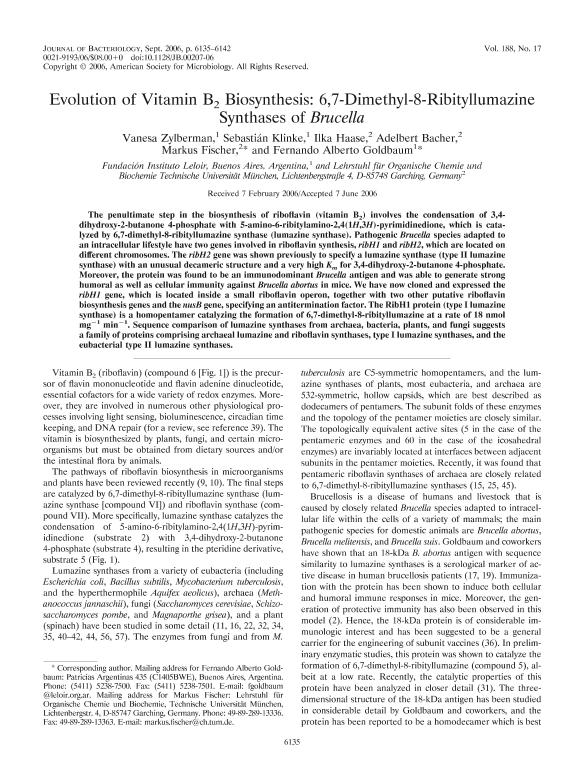Artículo
Evolution of vitamin B2 biosynthesis: 6,7-Dimethyl-8- ribityllumazine synthases of Brucella
Zylberman, Vanesa ; Klinke, Sebastian
; Klinke, Sebastian ; Haase, Ilka; Bacher, Adelbert; Fischer, Markus; Goldbaum, Fernando Alberto
; Haase, Ilka; Bacher, Adelbert; Fischer, Markus; Goldbaum, Fernando Alberto
 ; Klinke, Sebastian
; Klinke, Sebastian ; Haase, Ilka; Bacher, Adelbert; Fischer, Markus; Goldbaum, Fernando Alberto
; Haase, Ilka; Bacher, Adelbert; Fischer, Markus; Goldbaum, Fernando Alberto
Fecha de publicación:
09/2006
Editorial:
American Society for Microbiology
Revista:
Journal Of Bacteriology
ISSN:
0021-9193
e-ISSN:
1098-5530
Idioma:
Inglés
Tipo de recurso:
Artículo publicado
Clasificación temática:
Resumen
The penultimate step in the biosynthesis of riboflavin (vitamin B 2) involves the condensation of 3,4-dihydroxy-2-butanone 4-phosphate with 5-amino-6-ribitylamino-2,4(1H,3H)-pyrimidinedione, which is catalyzed by 6,7-dimethyl-8-ribityllumazine synthase (lumazine synthase). Pathogenic Brucella species adapted to an intracellular lifestyle have two genes involved in riboflavin synthesis, ribH1 and ribH2, which are located on different chromosomes. The ribH2 gene was shown previously to specify a lumazine synthase (type II lumazine synthase) with an unusual decameric structure and a very high Km for 3,4-dihydroxy-2-butanone 4-phosphate. Moreover, the protein was found to be an immunodominant Brucella antigen and was able to generate strong humoral as well as cellular immunity against Brucella abortus in mice. We have now cloned and expressed the ribH1 gene, which is located inside a small riboflavin operon, together with two other putative riboflavin biosynthesis genes and the nusB gene, specifying an antitermination factor. The RibH1 protein (type I lumazine synthase) is a homopentamer catalyzing the formation of 6,7-dimethyl-8-ribityllumazine at a rate of 18 nmol mg-1 min -1. Sequence comparison of lumazine synthases from archaea, bacteria, plants, and fungi suggests a family of proteins comprising archaeal lumazine and riboflavin synthases, type I lumazine synthases, and the eubacterial type II lumazine synthases.
Archivos asociados
Licencia
Identificadores
Colecciones
Articulos(IIBBA)
Articulos de INST.DE INVEST.BIOQUIMICAS DE BS.AS(I)
Articulos de INST.DE INVEST.BIOQUIMICAS DE BS.AS(I)
Citación
Zylberman, Vanesa; Klinke, Sebastian; Haase, Ilka; Bacher, Adelbert; Fischer, Markus; et al.; Evolution of vitamin B2 biosynthesis: 6,7-Dimethyl-8- ribityllumazine synthases of Brucella; American Society for Microbiology; Journal Of Bacteriology; 188; 17; 9-2006; 6135-6142
Compartir
Altmétricas



